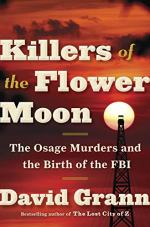|
This section contains 422 words (approx. 2 pages at 400 words per page) |

|
Killers of the Flower Moon: The Osage Murders and the Birth of the FBI Summary & Study Guide Description
Killers of the Flower Moon: The Osage Murders and the Birth of the FBI Summary & Study Guide includes comprehensive information and analysis to help you understand the book. This study guide contains the following sections:
This detailed literature summary also contains Topics for Discussion on Killers of the Flower Moon: The Osage Murders and the Birth of the FBI by David Grann.
The following version of this book was used to create this study guide: Grann. David. Killers of the Flower Moon: The Osage Murders and the Birth of the FBI. Doubleday, 2017.
Killers of the Flower Moon: The Osage Murders and the Birth of the FBI by David Grann describes a series of murders that came to be known as the Osage Reign of Terror. In the early 1900s, dozens of members of the Osage Native American tribe were murdered in a vast conspiracy. These murders were motivated by the Osage’s considerable wealth, a result of their relocation above major oil fields in northern Oklahoma. Over a period of many years, white members of the community orchestrated the killings and an elaborate cover-up to gain control of Osage headrights, which would entitle them to a share of the oil leases. Intervention by the nascent Bureau of Investigation, the predecessor of the modern FBI, solved some of the murders and led to conviction of several conspirators, but many crimes remain formally unsolved to this day.
The book’s early chapters focus on the family of Mollie Burkhart, an Osage woman married to the white Ernest Burkhart. After Mollie’s sister, mother, and others in the tribe were killed, authorities begin to suspect that they were being targeted because of their headrights. Nonetheless, local investigations were stymied by a lack of professional law enforcement and rampant corruption and evidence tampering. Following the death of Mollie’s sister and brother-in-law in a bombing, agents from Bureau of Investigation were sent to intervene. At the time, a new director named J. Edgar Hoover led the bureau, and he sought to use the Osage case to improve his agency’s reputation. Tom White, an experienced agent and former Texas Ranger, led the investigation. His team included several frontier lawmen, with experience in the region and with undercover operations. Eventually, they revealed that William Hale, Ernest’s uncle and a prominent member of the community, had organized several of the murders with the help of Ernest, his brother Bryan, and several other conspirators. Despite attempts to coerce witnesses and rig the trial in his favor, Hale was eventually convicted, though he did not serve the entirety of his life sentence.
The final section describes Grann’s modern research into the Osage tribe and the murders that affected them. He uncovers a series of additional killings in which Hale had no involvement, suggesting that the conspiracy of the Reign of Terror extended far beyond what was originally thought.
Read more from the Study Guide
|
This section contains 422 words (approx. 2 pages at 400 words per page) |

|



